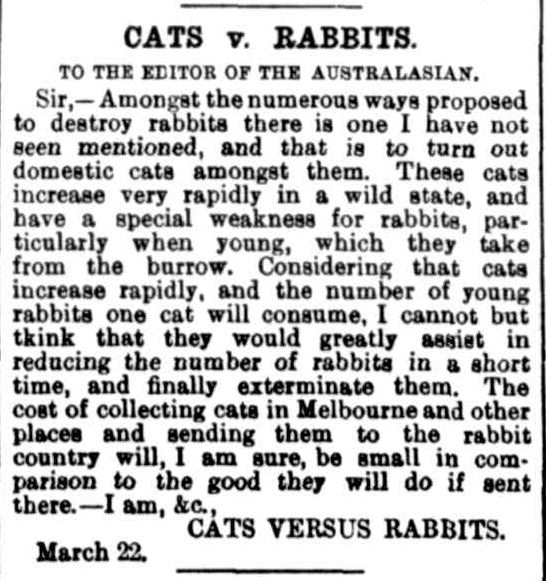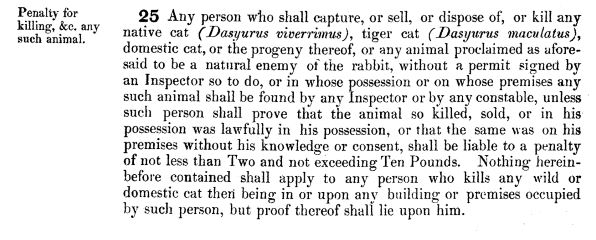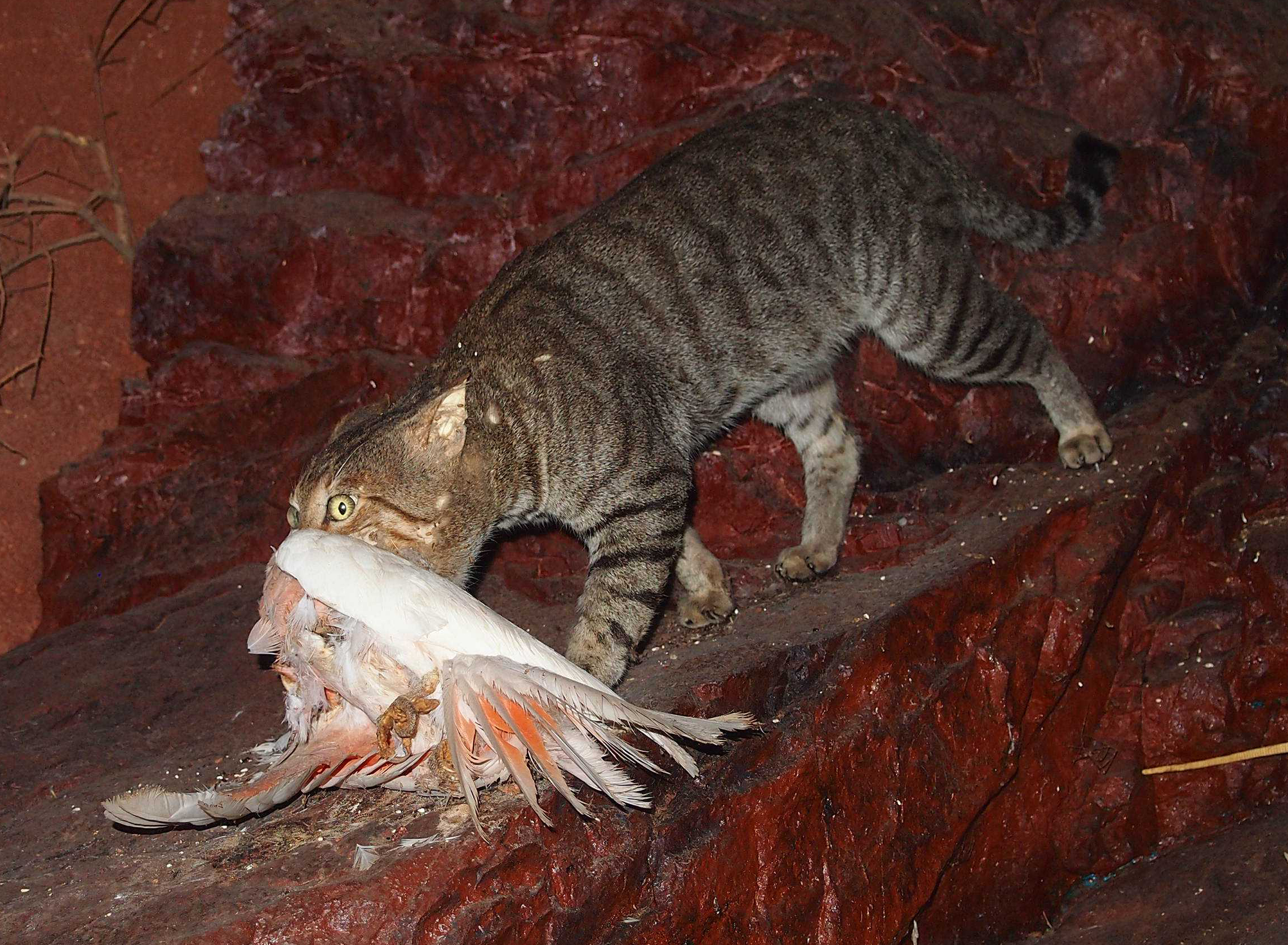
2,000 cats wanted in Australia. I looked at the above article from 1857 in horror and wondered about its authenticity. Surely not. My attention caught and completely distracted from my family history research, I began to search for more information. What I discovered was a story completely unknown to me; a story which has turned all that I’d known (and assumed) about feral cats completely on its head.
While I have yet to confirm whether the above article is real it was subsequent research which led me to discover more information about the story of cats in Australia. Before discussing cats however, it’s important to provide some background, namely, the history of the rabbit in Australia.
Domesticated rabbits were first introduced in Australia by the First Fleet in 1788. Most likely used as a source of food, they remained largely out of the early newspaper articles. They were eventually brought over to Tasmania and by 1827 it was noted that the wild rabbit population had exploded. While there was a rabbit population on the mainland, these seem to have been mainly kept in captivity. It wasn’t until the late 1850s that rabbits were released in several areas in the hope of establishing a population specifically for hunting. In 1859, 24 rabbits were released by Thomas Austin on his property in Victoria and it is said that the current infestation stems from this group.
As the rabbits bred and infested the whole country many options were looked at as a way to reduce their population and control the spread. Methods such as shooting, poisoning, destroying their warrens, building fences and spreading rabbit borne viruses were all employed at various points in time. One method occasionally mentioned in the history of the rabbit in Australia is the release of cats in the bush in the hope that they would kill and eventually eradicate the rabbits. Of course attempting to remove one pest with another introduced species was never going to work. While I’m sure pet cats have contributed to a fair share of the feral cat population, perhaps some of their numbers also originated in these early intentional releases.
Suggestions of using cats to eradicate the rabbits can be seen in the historical newspapers. An article printed in The Mercury (Hobart, Tasmania) in 1870 asked the question, “Why does not the Rural Municipality of Campbell Town offer a premium on the introduction into that district of wild cats?” Admitting that the feral cat would be considered extremely destructive, they further stated:

The rabbit problem continued and many people shared their opinions on how to get rid of them by writing to the newspapers. Their suggestions were overwhelmingly in favour of the release of cats into the bush.
In 1878 ‘Subscriber’ from Mount Rothwell, Little River said “I have seen in your columns a good many plans for keeping down the rabbits, but as I have not seen any notice taken of turning out tame cats and letting them run wild and breed among the rabbits, I would thank you to make this public by inserting it in your next issue.” Having tried the release of cats on his own property, he went on to say that he found them rather effective.
‘Anti-Vermin’ went a little further in their letter to The Australasian. They suggested that an Act be passed which would make it illegal to destroy domestic cats. Their thoughts hinged on the assumption that with domestic cats being protected (and not hunted by trappers) they would be free to go about their business which would include the hunting of rabbits.
The Leader (Victoria) received a letter from ‘Farmer’ of Dimboola advising that “…it may be of great advantage to all landholders to get as many cats as they possibly can, and let them loose on their holdings without feeding them.” He also bestowed some sage wisdom on the use of cats, “…nature works better than all Parliament laws…“
‘Bushman’ of Kurracca also wrote to the Leader in 1879:

While individuals and landholders were quick to point out the use of cats as a way to control the rabbits, it would seem that a mass release of cats wasn’t really reported until the 1880s. Opinions (in the form of letters to the editor) continued in much the same way.

In April 1881 it was widely reported in various newspapers that someone (the name was kept out of the papers) had released 200 domestic cats on his station in places where the rabbits inhabited. The report appears to have its origin in a Geelong newspaper so it can be assumed that this action probably occurred in Victoria. The individual stated that rabbits were no longer seen on the property and they provided an insight (albeit incorrect) into the future of feral cats.
The remedy certainly has the merit of simplicity, as it does not require any labour, and unless the cats develop new tastes it is not one of those which will prove worse than the disease.
Unfortunately the anonymity of the “enterprising” individual means that it’s impossible to ascertain whether such actions were indeed carried out or if the article itself was false.
These ‘evidence-based’ articles however continued to increase as others sought to prove the benefits of releasing cats in the bush and the success they’d had with the scheme. Names also began to be printed with letters and articles, perhaps as a way to add validity to what was being reported.

On 29 July 1885, the Geelong Advertiser reported that, three months prior to the article going to print, several hundred cats had been set free on the Woolamanata Estate which was located near Lara in Victoria. The cats had the desired effect on the rabbit population and it was noted that there was an “abundance of proof” in the form of rabbit skeletons lying about on the property.
[The cats]…are now scattered about in many directions. A process of acclimatising the domestic cats to the wilds of the bush has to be pursued…
Pleased with the results, those involved only had one real concern.

Others quickly followed suit. In 1885 the owners of Gogeldrie Station in New South Wales were said to have purchased 700 cats and released them in one go. The owner of Tarwin Station in Victoria wrote a detailed letter explaining how he went about exterminating the rabbits with about 50 cats. Tolarno Station (New South Wales) received 300 cats in late 1886.
Remarkably, such was the interest in cats versus rabbits, even the United Kingdom picked up the story and printed the details in various newspapers in 1886.

With the rabbit problem compounding and the land being overrun, it wasn’t long before Parliamentary Acts were passed. The Acts essentially placed the onus of eliminating rabbits on the shoulders of landholders. Inspectors were appointed by the Government and their duty was to inspect properties and issue notices ordering the landholder to take action against the rabbits if their property was found to be infested. Failure to do so would result in a fine.
The realisation that cats were helping with the problem meant that they too eventually became part of the Acts. Domestic cats (feral or otherwise) became protected under the Acts relating to the destruction of rabbits. Anyone found to have willingly captured, sold, disposed of or killed cats on their property (without a permit) would face a fine.

Sadly, not much changed in the 1890s. In 1892 an advertisement was placed in The Advertiser (South Australia) by the Willowie Land & Pastoral Association.

Shocked at so large a number, the newspapers contacted the Association to ascertain why so many cats were needed. They advised that while they could easily keep the rabbits at bay on the plains by covering the water with nets, they were unable to protect the gullies as netting was not an option. There were already 500 cats on the Wirrialpa Station and more, it seems, were necessary.
The past experience of the company has shown that no damage is done by the cats, which confine their attention solely to the unfortunate rabbits.
By 1893 it was reported by The Advertiser’s (Albany) Eucla correspondent that rabbits were getting closer to the Western Australian border and that travellers journeying from Fowler’s Bay in South Australia were known to have been killing rabbits for food. Despite the warnings in the papers, no action was taken. In early 1896 the news from Eucla read:
The rabbits have established themselves here now, beyond a doubt, and the advance guard, which passed here some 18 months ago, is doubtless nearing the goldfields by this time. I think that the Government will regret not having made the slightest effort to prevent the inroad of this pests into the colony.
The Western Australian Government did eventually take action against the rabbits. Three years later, in 1899, they decided to use cats.

The start of a new century saw no change. Newspapers continued to sing the praises of cats being left to roam in the bush so they could hunt rabbits. Anecdotes from the 1880s and more recent examples of cats being found to have ‘done their job’ were printed as if to justify their use. Proclamations continued to be made in Government Gazettes prohibiting the killing of domestic cats. On rare occasions, newspapers admitted that the cats may become a pest but stated “It’s all a question of the devil we know, and the devil we don’t know!“.
In searching for the phrase ‘feral cats’ on Trove the first instance of a newspaper printing their concerns with regards to domestic cats in the bush occurred in 1926. The Register (South Australia) printed a scathing article about the release of pests in Australia and the terrible damage they’d caused, and placed the blame firmly at the feet of European settlers.
…but the conclusion is inevitable, that the white man, who found the face of Nature smiling on this country, a hundred years ago, has since, with his own hands, and by his four-footed importations, changed the smile to an ominous frown.
It continued by pointing out that the problems started with the rabbit and further elaborated that in seeking to destroy the rabbit, man “let loose upon the fauna of this country a series of scourges which may yet be fatal to nearly all but itself.” While they touched upon the dingo as being an introduced species which, after thousands of years, became part of the Australian landscape, they made no exception with respect to the cat.
The domestic cat, however, has been assisted and encouraged to revert to the wild state of its original type.
After years of newspapers printing reports from individuals stating that cats killed the rabbits and that there was no harm in releasing them in the bush, finally, the truth was admitted.

Professor Frederic Wood Jones (an anatomist, naturalist and anthropologist) went on to say:
Apart altogether from questions of economic utility, these feral cats are a terrible scourge, when we consider the vast numbers of the more rare, interesting, and beautiful members of our native fauna that are annually destroyed by them.
Today millions of feral cats are still found roaming the bush along with the rabbit; the very creature they were initially meant to destroy. The words of Professor Wood Jones may have been printed in 1926 but they still ring true today. Found in every part of Australia, the feral cat still threatens the survival of our native fauna and has caused the extinction of several types of birds and mammals. According to the Australian Wildlife Conservancy (AWC), each night, feral cats kill millions of different native species across Australia.
Vital research carried out by organisations such as the AWC aim to reduce the impact of cats (there is no effective method of completely eradicating them). They’ve also established ‘feral-free’ fenced areas which provide a safe haven for native wildlife within the area by completely eradicating feral predators. In 2015, they announced that in Newhaven Wildlife Sanctuary in central Australia, a feral cat-free sanctuary (the largest feral cat eradication project in the world) will be established in order to return endangered mammals back to the area.
As human beings in the natural environment, we really do have a lot to answer for. Australia existed undisturbed for tens of thousands of years and in a little over 200 years (European settlement) we introduced species which decimated populations of native fauna. The early settlers may have been ignorant of the consequences of their actions but I truly cannot say that they meant well. Free Englishmen emigrated to a completely unknown country for a myriad of reasons (adventure, money, status) but despite doing so, many still sought to recreate what they’d left behind. Rabbits (and foxes) were released for hunting; a sport practiced by the upper classes in England and it seems that in seeking to re-establish a much loved recreation they started a chain reaction first with the rabbit and then with the feral cat.
It’s likely that it will take a very long time before the actions of the past are reversed and feral pests (including cats) are eradicated from the environment. The mistakes of the past have been acknowledged and now we must look to the future. It is through the hard work and research conducted by individuals and organisations such as the Australian Wildlife Conservancy which may in time help restore the balance in the Australian environment.
This blog post was written independently of the Australian Wildlife Conservancy and is in no way affiliated with them. However, if you wish to support them, their cause and the work that they do, please donate via: https://support.australianwildlife.org/
Sources:
- Derbyshire Times and Chesterfield Herald; 21 March 1857; Page 2.
- Wikipedia article ‘Rabbits in Australia’ (https://en.wikipedia.org/wiki/Rabbits_in_Australia).
- 1870 ‘CATS VERSUS RABBITS.’, The Mercury (Hobart, Tas. : 1860 – 1954), 31 May, p. 3. , viewed 24 Oct 2016, http://nla.gov.au/nla.news-article8866812
- 1878 ‘THE RABBIT NUISANCE.’, The Australasian (Melbourne, Vic. : 1864 – 1946), 26 October, p. 22. , viewed 24 Oct 2016, http://nla.gov.au/nla.news-article143002127
- 1879 ‘CATS V. RABBITS.’, Leader (Melbourne, Vic. : 1862 – 1918), 22 February, p. 7. , viewed 24 Oct 2016, http://nla.gov.au/nla.news-article198005331
- 1878 ‘RABBIT NUISANCE. PROTECTION FOR CATS.’, The Australasian (Melbourne, Vic. : 1864 – 1946), 9 November, p. 23. , viewed 26 Oct 2016, http://nla.gov.au/nla.news-article143002401
- 1878 ‘THE RABBIT NUISANCE.’, Leader (Melbourne, Vic. : 1862 – 1918), 16 November, p. 7. , viewed 26 Oct 2016, http://nla.gov.au/nla.news-article197280625
- 1881 ‘CATS v. RABBITS.’, The Australasian (Melbourne, Vic. : 1864 – 1946), 19 March, p. 25. , viewed 27 Oct 2016, http://nla.gov.au/nla.news-article137813512
- 1881 ‘ITEMS OF NEWS.’, Mount Alexander Mail (Vic. : 1854 – 1917), 14 April, p. 2. , viewed 27 Oct 2016, http://nla.gov.au/nla.news-article198691703
- 1882 ‘THE RABBIT NUISANCE.’, The Australasian (Melbourne, Vic. : 1864 – 1946), 15 July, p. 24. , viewed 28 Oct 2016, http://nla.gov.au/nla.news-article138080608
- Access to ‘The Rabbits Destruction Act 1883’ (Tasmania) courtesy of AustLII (http://www.austlii.edu.au/).
- Edinburgh Evening News; 29 September 1886. Courtesy of Findmypast.
- 1892 ‘Advertising’, The Advertiser (Adelaide, SA : 1889 – 1931), 16 July, p. 8. , viewed 30 Oct 2016, http://nla.gov.au/nla.news-article25332684
- 1892 ‘CATS AND RABBITS.’, The Express and Telegraph (Adelaide, SA : 1867 – 1922), 18 July, p. 2. (SECOND EDITION.), viewed 30 Oct 2016, http://nla.gov.au/nla.news-article208518739
- 1893 ‘ALBANY NEWS.’, The West Australian (Perth, WA : 1879 – 1954), 18 July, p. 2. , viewed 30 Oct 2016, http://nla.gov.au/nla.news-article3050548
- 1896 ‘NEWS FROM EUCLA.’, The Inquirer and Commercial News (Perth, WA : 1855 – 1901), 24 January, p. 6. , viewed 30 Oct 2016, http://nla.gov.au/nla.news-article72376842
- 1899 ‘NEWS AND NOTES.’, The West Australian (Perth, WA : 1879 – 1954), 8 April, p. 5. , viewed 30 Oct 2016, http://nla.gov.au/nla.news-article3223888
- 1901 ‘CATS v. RABBITS.’, The Sydney Stock and Station Journal (NSW : 1896 – 1924), 1 March, p. 2. , viewed 30 Oct 2016, http://nla.gov.au/nla.news-article121190838
- 1926 ‘The Register. ADELAIDE SATURDAY, JANUARY 23, 1926.’, The Register (Adelaide, SA : 1901 – 1929), 23 January, p. 8. , viewed 31 Oct 2016, http://nla.gov.au/nla.news-article64327576
- Information relating to the feral cat obtained courtesy of the Department of the Environment and Energy (https://www.environment.gov.au/biodiversity/invasive-species/feral-animals-australia/feral-cats).
- Information relating to the feral cat obtained courtesy of the Australian Wildlife Conservancy (http://www.australianwildlife.org/field-programs/feral-cat-research).
- Image of the feral cat courtesy of Wikipedia. By Mark Marathon (Own work) [CC BY-SA 4.0 (http://creativecommons.org/licenses/by-sa/4.0)%5D, via Wikimedia Commons.


I saw five rabbites on my lawn this arvo. Maybe I need a cat or two.
LikeLike
Really good research in this article, thank you.
LikeLike
Thank you. 🙂
LikeLike
To think that all these years later, cat lovers have been blamed for allowing their cats outside at night… when it was our ancestors who created the problems…
An interesting article…having been brought up in the country, we were well aware of the number of rabbits. In fact, in the small country seaside village that I called home, they have numerous rabbits, mainly cute white ones, wandering all around the town.
I don’t remember seeing any cats though 🙂
LikeLiked by 1 person
Very true, Chris. I had always blamed cat owners for feral cats before I wrote this story. I couldn’t believe it when I learned that people of the past released them en masse. Such a silly step to take but the rabbits were such a problem that I guess they were desperate. Here’s hoping, going forward, we can try to fix the problems caused by past decisions.
LikeLiked by 1 person
We can but try, Jess… though I’m sure that future generations will look back at our lives and shake their heads in disbelief just as we have for past generations.
Tha moral of the story is to do the best you can with what you’ve got…
LikeLike